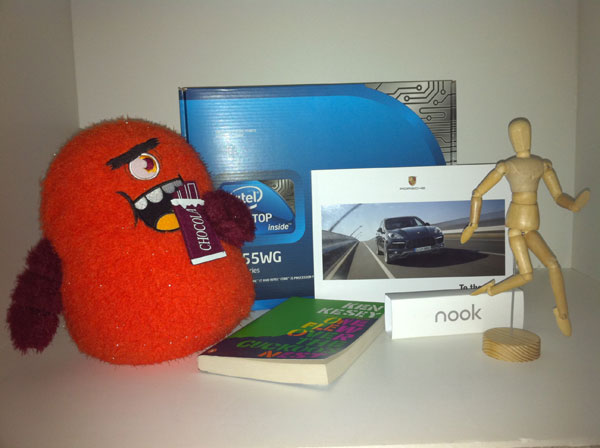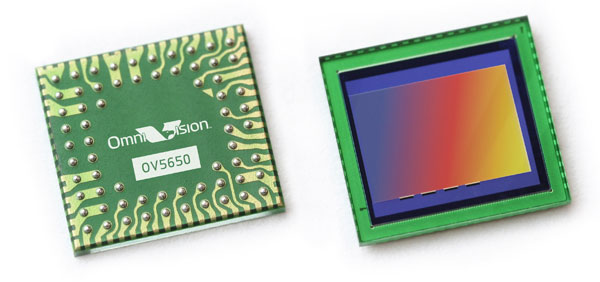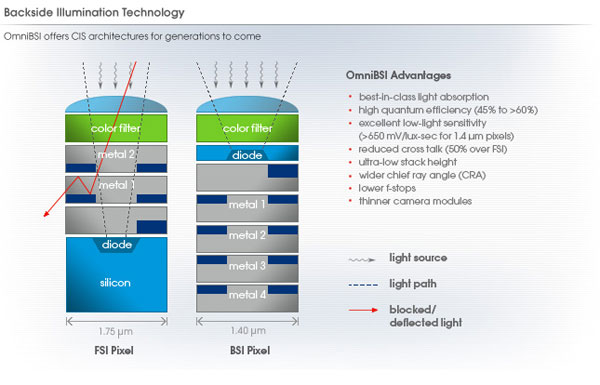Apple's iPhone 4: Thoroughly Reviewed
by Brian Klug & Anand Lal Shimpi on June 30, 2010 4:06 AM EST- Posted in
- Smartphones
- Apple
- iPhone 4
- Gadgets
- Mobile
Welcome to 2010, Apple Upgrades its Camera
The iPhone 4 is equipped with two cameras: a 5 megapixel camera with LED flash on the back of the phone and a VGA camera with no flash on the front. The LED flash works in both still and video modes. Like the EVO 4G, the iPhone 4‘s flash allows you to shoot in perfect darkness. If you’re filming a video in low light the LED will stay illuminated while you’re recording.

Taken with the iPhone 4 in total darkness
The same unfortunately can’t be said for the front facing camera on the 4. In anything but good lighting you’re going to get noise. It’s really only useful for FaceTime (or as an alternative to a mirror) and even then you need to be well lit for it to look decent.
Apple has opted for a 5 megapixel OmniVision sensor for the rear camera on the iPhone 4. What's interesting is that Apple has decided to bring backside illumination front and center with their marketing.
Backside illumination improves the sensitivity of CMOS and CCD detectors by reducing the amount of material in the path of incident light. In a frontside illuminated detector, a considerable amount of light is lost due to absorption that doesn't result in emission of an electron, in addition to reflection off pixel structures and electrical components near the frontside surface. Backside illumination greatly improves sensitivity by flipping the stack over. Instead of light having to pass through and possibly be reflected by metal structures, it is converted into electrons and read out by passing solely through silicon. Creating a backside illuminated part isn't as simple as flipping a sensor over, however, as manufacturers also generally thin the silicon light has to pass through before it can reach the photodiode. This further improves sensitivity and is generally accomplished through chemical etching in acid or by lapping (physically grinding) sensors at wafer scale.

OmniVision OV5650 - iPhone 4's rear camera SoC
Though backside illumination (BSI) improves quantum efficiency (how many photons are converted into electons), backside illumination is hugely important for another serious reason as well. Because the sensor is small at 4.6 mm by 3.4 mm, pixel size is also extremely small at just 1.75 microns square for the OV5650 in the iPhone 4 (state of the art sensors are 1.4 microns square, like those in the HTC Incredible's 8 MP sensor). Frontside illuminated parts generally have in the neighborhood of 10-15 microns of silicon before the active region of the photodiode where one wants photons to get converted to electrons. The result is that without backside illumination, pixels have a 10:1 ratio of height to length, you can visualize them as looking something like long square pillars. But that's a problem.
As photons are converted into electrons in that silicon, there's no guarantee that it will immediately travel down into the gate structure below to be read out by the camera. Electrons drift as they descend these columns, meaning that photons incident on one pixel don't necessarily map to the gate below. Because the smartphone camera sensors are so small, with a 10:1 ratio of height to size, the result is large amounts of so-called quantum blurring from electrons traveling into the gate structures of adjacent pixels. The result is a blurry image (and a decrease in MTF at the sensor level!), thus not representing the image that used to be incident on the sensor.
OmniVision and other smartphone CMOS sensor manufacturers thin that column down in an effort to come closer to having the pixel look more like a cube than a huge pillar. Ballpark numbers are between 3 and 6 microns, down from 10-15. The result is much more sensitive sensors that are higher resolution. While megapixels don't necessarily matter, neither does pixel size as much anymore; it's all about quantum efficiency, which is what engineers really care about.

OmniVision BSI - Courtesy OmniVision
The optical system of the iPhone 4 is difficult to characterize without disassembly, though the focal length is a bit shorter than previous iPhones. The result is that the photos are demonstrably wider angle. Backside illumination also allows for a bigger chief ray angle, higher numerical aperture (and thus lower f/#), but I won't bore you with the details.










270 Comments
View All Comments
Dark Legion - Wednesday, June 30, 2010 - link
Not to be a grammar nazi, but since I'm posting other things anyway..."Even Palm entered the race with a competent offering, and Microsoft isn't far behind."
Both the Evo and Incredible have 8GB built in + room for 16GB microSD (though they come with 8GB microSD?), and the Incredible also has dual LED flash.
SimKill - Wednesday, June 30, 2010 - link
I just printed this to a PDF, and its 75 freaking pages... Holy bleeding batman(in a good way) It's longer than even some magazines, 1 article.AWESOME
(I think it would be perfect on a Kindle...hmm next thing to buy :evilgrin: )
It's going to make for a nice evening read.
griffonu - Wednesday, June 30, 2010 - link
Really cool review! The first informative one in a general noise of non-sense and subjective opinions on the net./bow
Furuno - Wednesday, June 30, 2010 - link
I don't now what should I say about those $29.99 bumper case... It's even more expensive than my $15 "backup" phone...And I wonder why you're so excited about video call? isn't this is an old technology already? I've been doing this since high school with Nokia 3G's phone (forget the name).
I still prefer N900 tough, mostly because of it's Debian-based OS. As a programmer that's usually works with a Linux machine it's just incredible. Like, wow I can do apt-get install on my phone!
Oh, and thanks for the in-depth antenna issue explanation! Great article!
Griswold - Wednesday, June 30, 2010 - link
I'd rather like to know what apple says about the bumper cases. They cost them maybe a dollar at the most to make and they sell it for 29 bucks. Thats a fucking fat cash cow right there and it explains why they refuse to hand one out for free. What would you rather have? $2m spent in a couple weeks for satisfied customers or $56m profit from partly annoyed customers?(yea I read it, the issue is not really an issue and not everyone is going to buy a bumper case... its anecdotal)
JAS - Wednesday, June 30, 2010 - link
Indeed, Apple's pricing for its Bumper is outrageous. Who would pay $29 for a small piece of plastic? But if you are running a corporation, have a legal responsibility to shareholders to maximize profits, *and* customers are willing to buy a product at the listed price ... ?How long will it be until a third-party case maker introduces its own perimeter case for under $10?
kmmatney - Wednesday, June 30, 2010 - link
It won't be long at all. I bought by 3GS rubber case for ~$2 on dealextreme. It's now even cheaper:http://www.dealextreme.com/details.dx/sku.11687#op... full view
I agree that they should give away the cases for free, or heavily discounted . In any case, I don't anyone is crazy to not use a case on such an expensive device. You're going to drop it sometime.
Screammit - Thursday, July 1, 2010 - link
I'd have to agree with the video call bit, other phones (evo in particular) can do video calls over 3g AND can interface with computers through applications like Fring and Skype. I'm sure the video quality to only other iphone 4 users is stellar, especially over wifi, but isn't it a tad restrictive?archcommus - Wednesday, June 30, 2010 - link
I'm sorry, as much as I love Anandtech and Anand's in-depth and candid articles in particular, the bias here towards Apple is extremely strong. This article is night and day compared to the EVO review just posted. This is direct, interesting, discusses real impressions - EVO review was just a list of facts and things we mostly already knew. Honestly, it shouldn't have even been posted. I've gotten similar feelings about other Android reviews (Droid review 6 months after release? really?). I come to Anandtech to expect this level of quality in all articles, regardless of personal preference. As I said, I usually love your content Anand, but really the only thing I'm following of yours now are your SSD articles. All the rest of your attention goes towards Mac/iPhone.Griswold - Wednesday, June 30, 2010 - link
Have to agree, even though it assured me that my plan to get that phone is a good plan.Too much apple brown nosing.